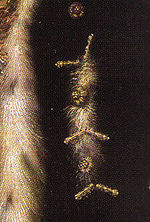.gif)
Aiguillette (ornament)
Encyclopedia

Cord (sewing)
In sewing, cord is a trimming made by twisting or plying two or more strands of yarn together. Cord is used in a number of textile arts including dressmaking, upholstery, macramé, and couching.Soft cotton cord forms the filling for piping.-References:...
or ribbon
Ribbon
A ribbon or riband is a thin band of material, typically cloth but also plastic or sometimes metal, used primarily for binding and tying. Cloth ribbons, most commonly silk, are often used in connection with clothing, but are also applied for innumerable useful, ornamental and symbolic purposes...
, usually of gold
Gold
Gold is a chemical element with the symbol Au and an atomic number of 79. Gold is a dense, soft, shiny, malleable and ductile metal. Pure gold has a bright yellow color and luster traditionally considered attractive, which it maintains without oxidizing in air or water. Chemically, gold is a...
and sometimes set with gemstone
Gemstone
A gemstone or gem is a piece of mineral, which, in cut and polished form, is used to make jewelry or other adornments...
s or enamel
Vitreous enamel
Vitreous enamel, also porcelain enamel in U.S. English, is a material made by fusing powdered glass to a substrate by firing, usually between 750 and 850 °C...
ed. Small cords and ribbon bows tipped with pairs of aiguilettes were fashionable ornaments in the 16th and early 17th centuries.
In contemporary military and civil uniforms, an aiguillette
Aiguillette
An aiguillette is an ornamental braided cord most often worn on uniforms, but may also be observed on other costumes such as academic dress, where it will denote an honour. Originally, the word "aiguillette" referred to the lacing used to fasten plate armor together...
is an ornamental braided cord with a similar metal tip, derived from armor fastenings. The plastic or metal aglet
Aglet
An aglet is a small plastic or metal sheath typically used on each end of a shoelace, cord, or drawstring. An aglet keeps the fibers of the lace or cord from unraveling; its firmness and narrow profile make it easier to hold and easier to feed through the eyelets, lugs, or other lacing...
on a shoe lace is also a direct descendant.
Uses


Silver-gilt
Silver-gilt or gilded/gilt silver, sometimes known in American English by the French term vermeil, is silver gilded with gold. Most large objects made in goldsmithing that appear to be gold are actually silver-gilt; for example most sporting trophies, medals , and many crown jewels...
, or gold.
Surviving portraits show that aiguillettes could be functional or purely decorative, though many were used to "close" seams and slashes that are not always apparent on dark garments in portraits. They were made in matched sets and were worn in masses. The Day Book of the Wardrobe of Robes of Elizabeth I of England
Elizabeth I of England
Elizabeth I was queen regnant of England and Ireland from 17 November 1558 until her death. Sometimes called The Virgin Queen, Gloriana, or Good Queen Bess, Elizabeth was the fifth and last monarch of the Tudor dynasty...
records items given and received into storage, including details of buttons and aiguillettes lost from the Queen's clothing:
Lost the 2 of February ... [1582] 1 bunsh of small gold tagges or aglettes from a gowne of black satten at Sittingbourne parcell [part] of uppon the same gowne 193 bunshes
Elizabeth's aiguillettes were variously enameled with white, red, black, blue, and purple details or set with diamond
Diamond
In mineralogy, diamond is an allotrope of carbon, where the carbon atoms are arranged in a variation of the face-centered cubic crystal structure called a diamond lattice. Diamond is less stable than graphite, but the conversion rate from diamond to graphite is negligible at ambient conditions...
s, garnet
Garnet
The garnet group includes a group of minerals that have been used since the Bronze Age as gemstones and abrasives. The name "garnet" may come from either the Middle English word gernet meaning 'dark red', or the Latin granatus , possibly a reference to the Punica granatum , a plant with red seeds...
s, rubies
Ruby
A ruby is a pink to blood-red colored gemstone, a variety of the mineral corundum . The red color is caused mainly by the presence of the element chromium. Its name comes from ruber, Latin for red. Other varieties of gem-quality corundum are called sapphires...
, and those of Anne of Denmark
Anne of Denmark
Anne of Denmark was queen consort of Scotland, England, and Ireland as the wife of King James VI and I.The second daughter of King Frederick II of Denmark, Anne married James in 1589 at the age of fourteen and bore him three children who survived infancy, including the future Charles I...
in the early years of the 17th century were larger, shaped in triangles and pyramids. One set of 24 were made three-sided, with "27 diamonds in the sides and one in the top", for a total of 642 diamonds in the set.
See also
- 1500–1550 in fashion
- 1550–1600 in fashion
- 1600–1650 in fashion
- AgletAgletAn aglet is a small plastic or metal sheath typically used on each end of a shoelace, cord, or drawstring. An aglet keeps the fibers of the lace or cord from unraveling; its firmness and narrow profile make it easier to hold and easier to feed through the eyelets, lugs, or other lacing...

